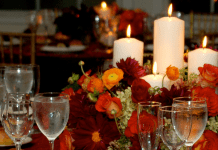 Altar space is a personal and sacred space. Some people leave their altars out in the open, while others keep them shielded from public eyes. Some people have very elaborate setups while others have very simple displays. Regardless of which way you go, your altar is about you, and the needs of your practice.
Altar space is a personal and sacred space. Some people leave their altars out in the open, while others keep them shielded from public eyes. Some people have very elaborate setups while others have very simple displays. Regardless of which way you go, your altar is about you, and the needs of your practice.
For my own practice, I have two small altars. I do not have much space, and I wanted my altar to be in a place that I would constantly see it, so that it was sure to get proper attention from me. It is in two parts, the main section is made from a wooden serving tray. The secondary section is a small wooden shrine that holds a single idol and her offering tray.
The main altar space holds a number of crystals, some idols that can be with each other, and my honey jar. The pen I use to write invocations is also in this space. All of the things included on my altar are things that are important to my practice, and my space looks very different from someone else who may follow the same beliefs, because they practice differently.
The key to setting up a successful altar that enriches your practice rather than feels like something else you have to take care of is to make it personal to you.
What are altars for?
Altars serve many purposes. For some people they are a place to honour their deities. Others build them as a way to connect and commune with their ancestors. Sometimes they are a space for both, and other times you they are for neither. You do not have to engage in deity worship or ancestor work to have an altar. You can make an altar to whatever you want that makes you feel powerful and fulfilled.
In my self-care article, I shared information on building an altar for honouring yourself as a way to uplift your own spirit.1 You can also build altars honouring the natural world, or aspects of humanity if you want. At their most basic, altars are a space for you to connect with whatever energy gives you strength and fulfillment. There are some common altar types:
Ancestor altar
These are created to help form a connection with ancestors. They often feature pictures of passed loved ones as well as personal items that help remind the practitioner of their family members. There’s usually a cup and plate for offerings of food and drink.2
Deity altar
These are built to worship deities or spirits. They can be shared space, if the particular entities allow for such things. They often have space for leaving offerings, lighting incense or candles, as well as items that are pleasing to that spirit. They also feature idols to stand in for the gods or spirits who are being honoured in the space.
Nature altar
Many people set up space honoring the natural world. These altars often feature representations of the elements, such as stones or seashells. There generally isn’t space for offerings.
Temporary altar
These sorts of altars are built for specific events such as a festival to honour a specific deity, or to perform a specific magical rite. They are also built for holidays and rituals. These are meant to be dismantled after the event is over, or easily walked away from.
The first step in creating an altar is determining what your altar’s purpose will be. That will guide you in knowing what you need to put on the altar as well as any special requirements for placement. Obviously, if you’re not using your altar to worship any deities, then it is more likely that you will have more freedom with what you want to build.

How to build an altar
The second concern is space. If you do not have much room, you won’t be able to comfortably build a floor to ceiling extravaganza and will need to decide on an area that works well for you. Here are some popular ideas:
Small tables
Coffee tables and end tables are often used for altar space as they can be moved easily and offer a clean flat service for a variety of things. They also can be thrifted easily. (Remember to cleanse them before use!)3
Dresser tops
Many people use the tops of their dressers, as it’s out of reach for many pets and children. It’s also in a place that people will see and interact with daily. However, some people do not feel comfortable having altar space in their bedroom.
Cabinets
Another thing that can be thrifted are cabinets. These provide a good deal of space as well as levels that you can use for different purposes.
For small spaces you can borrow room on desks, dressers, bookshelves, etc. Just be sure not to let non-altar items creep into altar space.
You must also consider your privacy. If you are in the “broom closet” so to speak, even if you have the space for a large set up, you may not be comfortable with displaying an altar so openly. There are a few options for this as well.
Mobile
These alters are small, and can fit inside of small boxes or tins. They are not very flashy, but they work just as well for people who cannot have a permanent set up in their home.4
Suitcases
You can build an altar inside of a suitcase that can be slid under beds, or kept in corners. They close, and can even be locked. The hard case type work better for this.
Closets
You can also build small altars inside of closets that can be closed.

What should be on an altar?
This is a tricky question, because every altar is different. Even “basic” things may be left off of some altars as per the needs of that particular practice. Here are some ideas to get you started:
Something that differentiates it from the surrounding area
If your altar is on a completely separate surface, you may not need a cloth or any table cover as they whole space is the altar. If your altar is in a shared area, such as a work desk or the top of a dresser, then using something to signal that this space is altar space will help keep it neat and orderly. You can build or purchase a small box or crate to act as a shrine, or even a tray to set things in.
A place for offerings
Having a set place, a dish or small tray, for this purpose will help you keep track of what you leave (and what you’ll need to clean up).
Clear space for temporary items
It’s a good idea to leave a clear space for temporary items. You might place new divinatory tools upon your altar to be blessed or charged, for example, or icons to represent particular issues you need help with, or are seeking strength of guidance for. Having a space already cleared for this purpose means that you won’t be upsetting the order of your altar when you need a little space.
Things that mean something to you
Not every altar will have personal effects, but many will. These are things that mean something to you and help form a channel between you and your practice. It could be a painting or a curio. It may be an idol or it could be a certain incense. This is entirely up to you and your needs.
Candles and incense
These are both mainstays of any altar. Many people light candles and incense as both a cleansing method and a small offering. Not everyone can light these things however. Some suitable substitutes are electric candles, which come in a wide variety of colours and types. Essential oils can also be used to add a bit of scent.5
Your changing worship space
This is only the beginning of what your altar may look like or what you need. As you grow in your practice, what you display may change. You might move into a larger house and have room for something more elaborate, or move into a tiny apartment and need to downsize. And that’s fine!
Your altar can be a dynamic place where you add and remove things as you grow in your practice. The important thing is that you remain knowledgeable in the practices you are engaging in. If you are worshiping spirits and deities, take some time to learn how they have been worshiped, don’t start rewriting living histories, be respectful.
Other than that, there’s no wrong way to build or have an altar. It’s your space, enjoy it!
Image credits: Linden Tea, littlehonda_350, and Kathy Crabbe Art
- See Donyae Coles’ “Three magical self-care rituals: Uplift, energize, and protect.” [↩]
- See Susan Starr’s article, “How to build an ancestor altar,” and Kalagni’s course, Ancestor Work Fundamentals, for information on building ancestor altars. [↩]
- See Donyae Coles’ article, “Four fall cleansing rituals for mind, body, and spirit,” for more ideas on how to cleanse. [↩]
- See Laura Perry’s article, “Portable shrines: You can take it with you,” for more information on creating mobile altars and shrines. [↩]
- See Donyae Coles’ article, “Hoodoo candle magick primer.” [↩]








